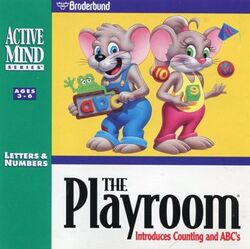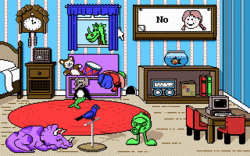Software:The Playroom (1989 video game)
| The Playroom | |
|---|---|
 Windows cover art | |
| Developer(s) | Broderbund |
| Publisher(s) | Broderbund Infogrames (Amiga) |
| Designer(s) | Leslie Grimm[1] Dennis Casewel Lynn Kirkpatrick |
| Artist(s) | Donna Buttlaire[2] |
| Composer(s) | Tim Larkin Greg Rahn |
| Series | Early Learning Family Series |
| Platform(s) | Amiga, Apple II, DOS, FM Towns, Macintosh, Windows |
| Release |
|
| Genre(s) | Educational |
| Mode(s) | Single-player |
The Playroom is a video game first created in 1989 for DOS, Apple II and Macintosh computers. The game was compatible with the TouchWindow utility.[3] It was ported to the Amiga and FM Towns computers in 1992 and 1994 respectively and then remade for Microsoft Windows and Macintosh in 1995. It was designed for ages 3 to 6 (preschool through first grade) manufactured by Broderbund. A follow-up game titled The Treehouse came in 1991 as well as a sequel to this game, called The Backyard in 1993.
Gameplay
The Playroom featured Pepper Mouse and is set in his playroom. Clicking on toys and areas of the playroom will activate animated surprises or open an activity.[4] Activities include the spinner, a simple counting game with four difficulty levels; an ABC book, where objects can be placed on two different scenes; the computer, which teaches spelling and getting familiar with the keyboard; the cuckoo clock, which teaches how to tell time; the mousehole game, which is a dice-rolling game with three skill levels; and the mix-up toy, in which heads, torsos and legs from various characters can be customised.[5] The 1995 remake includes additional content to the existing activities[6] and the presence of Pepper's sister Ginger.
Educational goals
The game is designed to make younger players comfortable to their surroundings as they become absorbed in the activities,[7] helps them get ready for school[8] and offers them learning opportunities in a non-threatening manner.[3] Literacy skills are not required to play it.[9] Topics in the game include simple math, reading, time and reasoning skills.[10] It pays great attention to detail, clearly spelling out meanings to make reading letters and words plus typing easy. There are also activities to teach telling the time, counting and using imagination. The user manual also includes fun activities to add to enjoyment.[11] Copies of the game also came with a stuffed toy of Pepper Mouse.[12] Aided by this software, Children can learn and advance at their own pace and play in their own way.[13]
Reception
| Reception | ||||||||||||
|---|---|---|---|---|---|---|---|---|---|---|---|---|
| ||||||||||||
| ||||||||||||
The Playroom won six Early Learning Awards.[19] Computer Gaming World gave the game four stars out of five, calling it "clever and engaging"[15] and placed it as one of the SPA Top Hits for Home Education.[20]
The game was reviewed in the Oppenheim Toy Portfolio Guide Book where the authors described it as "virtual reality for three- to six-year-olds" and claimed that "[t]here is real education going on behind the scenes of this creative playroom".[21]
Availability
The game was included on a twin CD pack along with "Jamie Discovers Math".[22]
References
- ↑ Leslie Grimm Ph.D.. Talking Fingers Inc.. p. 1. http://www.talkingfingers.com/press/downloads/grimm_bio.pdf. Retrieved 3 June 2016.
- ↑ Donna Steiner Buttlaire. "Donna Buttlaire Portfolio". http://www.donnabu.com/. Retrieved September 22, 2018.
- ↑ 3.0 3.1 Clark, Letha (1993). "The Playroom: Opportunities for Exploration and Discovery". ACTTion News: 6. https://files.eric.ed.gov/fulltext/ED378773.pdf.
- ↑ Broderbund Catalog. Broderbund Software. 1989. p. 48. https://mocagh.org/broderbund/broderbund-catalog2.pdf.
- ↑ Beth Ann Murray (February 1992). "Compute! Issue 117". Compute! (117): 90. https://archive.org/stream/1990-02-compute-magazine/Compute_Issue_117_1990_Feb#page/n91. Retrieved June 6, 2015.
- ↑ David H. Mann (1995). "The Playroom Windows/Mac". https://www.atariarchives.org/cfn/12/05/03/0525.php. Retrieved September 22, 2018.
- ↑ "The Learning Game - Ripe for Exploring". Game Players PC Entertainment (GP Publications) 5 (3): 42. https://archive.org/stream/GPPCEVol5No3/GPPCE_Vol_5_No_3#page/n43.
- ↑ "Fax - The Playroom". Guida Videogiochi (Jackson) (14): 6. September 1990. https://archive.org/stream/Guida-Videogiochi-14#page/n5.
- ↑ Himowitz, Michael (October 8, 1990). "Playroom puts computers in the hands of preschoolers" (in en). Baltimore Sun. http://articles.baltimoresun.com/1990-10-08/features/1990281106_1_playroom-toy-displays-mouse-hole.
- ↑ Lewis, Peter H. (April 8, 1990). "A Hard Look at Software; Romper Rooms" (in en). New York Times. https://www.nytimes.com/1990/04/08/education/a-hard-look-at-software-romper-rooms.html.
- ↑ "Games for Kids Teach while they Entertain" (in en). Deseret News. https://www.deseretnews.com/article/137493/GAMES-FOR-KIDS-TEACH-WHILE-THEY-ENTERTAIN.html.
- ↑ Brøderbund Catalog. Brøderbund. p. 30. http://mocagh.org/broderbund/broderbund-catalog2.pdf. Retrieved 3 June 2016.
- ↑ Raskin, Robin (February 13, 1990). "The Playroom lets Children Advance at their own Pace". PC Magazine (Ziff Davis) 9 (3): 383–384. https://books.google.com/books?id=ByIl6BeV7z8C&pg=PT386.
- ↑ Lisa Karen Savignano. "The Playroom - 1995 Review - allgame". Allgame. http://www.allgame.com/game.php?id=16890. Retrieved June 2, 2016.
- ↑ 15.0 15.1 Ackelson, Caitlin (June 1991). "Kaptivating Komputer Games Katch Kids' Imaginations". Computer Gaming World (83): 84. https://archive.org/stream/Computer_Gaming_World_Issue_83#page/n83.
- ↑ 16.0 16.1 http://elisoftware.org/index.php?title=Learning_Advantage_Library_1_(PC_and_Mac,_CD-ROM)_Broderbund_Software_-_1996_USA,_Canada_Release [|permanent dead link|dead link}}]
- ↑ "SIIA Codie Awards". https://www.siia.net/codie/About-the-Awards/Past-Winners/1990-Winners. Retrieved December 14, 2016.
- ↑ "Broderbund - Awards Showcase". Broderbund. August 1995. http://www.broder.com/store/awards.html. Retrieved September 22, 2018.
- ↑ "PC Museum - The Playroom". http://www.pcmuseum.ca/details.asp?id=39061&type=software. Retrieved September 21, 2018.
- ↑ "PC Research/SPA Top Hits". Computer Gaming World (94): 58. May 1992. https://archive.org/stream/Computer_Gaming_World_Issue_94#page/n57.
- ↑ Oppenheim, Joanne and Stephanie (1993). The Best Toys, Books & Videos for Kids. Oppenheim Toy Portfolio Guide Book. 1 (1st ed.). New York: Harper Perennial. p. 272. ISBN 0-06-273196-3.
- ↑ "Computers - Broderbund" (in en). The Age. July 29, 1997. https://www.newspapers.com/newspage/123052473/.
External links
 |


